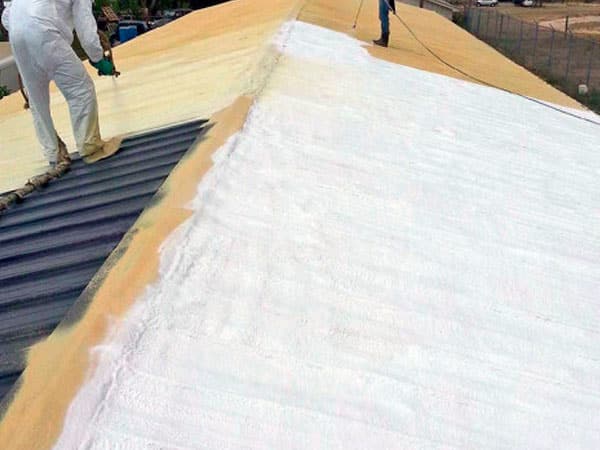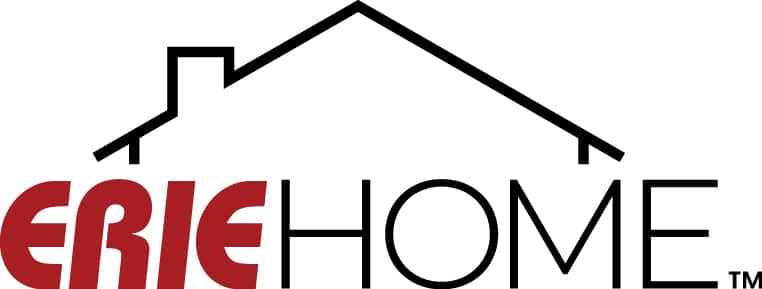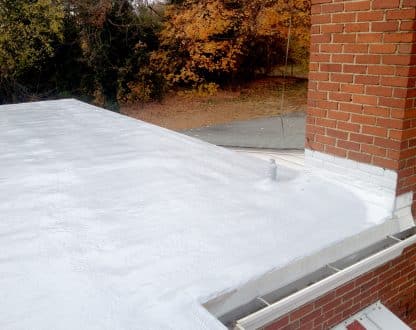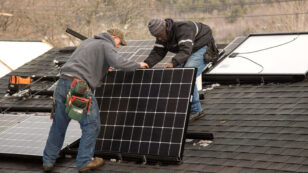 Policy
Policy

Foam Roof Cost and Homeowners Guide (2024)
Average Foam Roof Cost: $2,500 – $7,500
- Foam roofs are highly durable, lasting 30 or more years
- Foam is an energy efficient roofing material, leading to 40% energy savings
- The average price for foam roofing is $1 to $3.50 per square foot
Each product and or company featured here has been independently selected by the writer. You can learn more about our review methodology here. If you make a purchase using the links included, we may earn commission.
Spray polyurethane foam (SPF) has been used as a roofing, insulation and sealing solution for decades. Although mainly used for commercial buildings, many homeowners have used foam insulation and can take advantage of the benefits of spray polyurethane foam roofing.
Surprisingly, SPF has been shown to be an extremely sustainable and environmentally-friendly roofing material. Combining your new foam roof with solar panels is a great way to go green.
Your bank account will also benefit from roof replacement using foam. Foam roofs cost between $2,500 and $7,500 for the average 1,700 square foot roof, making it the cheapest roofing material. SPF roofing has also been shown to increase energy savings up to 40%.1
Of course, the cost of your foam roof installation will vary depending on your roofing company, roof size and complexity and other factors we’ll touch on throughout this article.
Cost of Installing a Foam Roof
The average cost of a foam roof installation ranges from $2,500 to $7,500, or between $1 to $3.50 per square foot. Our price range has been calculated for the average U.S. roof size of 1,700 square feet.
Remember that costs can vary depending on your roof’s size, slope, pitch and layout, as well as local installation costs in your area.

How to Calculate the Cost of Your New Foam Roof
The only way to know exactly how much your new roof will cost is to get one or more free estimates from a professional roofing company. But if you’d like to get a ballpark idea of the cost, follow these two steps to calculate your new roof installation:
- Determine the square footage of your roof
- Multiply the square footage by $1-$3 to get your foam roofing material cost
Foam roofing cost estimate = roof size x foam material cost per square foot
Again, we want to stress that this is just a rough estimate. You can expect to pay more for additional materials (like underlayment) as well as roofer labor and old roof removal if it’s necessary.
If you’d like to get a free, no-obligation quote from one of the top roofing companies near you, click here.

Power Home

Average cost
Pros
- Positive industry reputation
- Lifetime or lengthy warranty
- 10+ years of experience
- Positive customer reviews
- Uses eco-friendly materials
- Well-trained, certified installers
- Variety of roofing styles available
Cons
- Limited variety of roofing materials
- Short or nonexistent warranty
- No financing information available
- Expensive
- Little information available on company website

Erie Home

Zero Down - 18 months same as cash with minimum monthly payment
Average cost
Pros
- Lifetime or lengthy warranty
- Widespread availability
- 10+ years of experience
- Positive customer reviews
- Uses eco-friendly materials
- Financing options available
- Well-trained, certified installers
- Uses durable materials meant to last
- Variety of roofing styles available
Cons
- Limited variety of roofing materials
- Expensive

Aspen Contracting

Average cost
Pros
- Positive industry reputation
- Lifetime or lengthy warranty
- Widespread availability
- 10+ years of experience
- Positive customer reviews
- Financing options available
Cons
- Little information available on company website
Pricing Factors for Foam Roofs
You might be wondering why spray foam roofing costs anywhere from $2,500 to $7,500. That’s a pretty wide price range. And besides, how hard is it to spray foam?
There’s more that goes into spray foam roofing systems than you’d think. Let’s look at the factors your roofing company will consider when evaluating the cost of your foam roof.
Material Pricing for Foam Roofs
There aren’t as many different material options for foam roofing compared to most other roofing materials like asphalt shingles, but there are roof coating and sealants involved with foam roofing.
Spray foam comes in two forms: open cell and closed cell. Open cell foam is mainly used for an interior insulation layer, while closed cell foam can be used for residential and commercial roofing.
The table below shows some of the material costs involved in spray foam installations.
| SPF Roofing Component Material | Estimated Material Price Range (sq. ft.) |
| Primer for metal substrate (underlayment) | $0.50 – $0.80 |
| Primer for non-metal substrate | $0.15 – $0.30 |
| Closed cell spray | $0.80 – $1.00 |
| Protective silicone topcoat | $0.05 – $0.10 |
| Granules | $0.05 – $0.10 |
Your foam roofing contractor will spray a primer over the roof deck or underlayment, followed by the SPF mixture. It will go on as a liquid and then expand to typically 1 to 1.5 inches to form a dense foam layer.
Finally, your installer will apply elastomeric silicone or acrylic roof coating to protect the roof from UV rays, fire, weather, and objects like hail that could strike your roof and damage it. For extra protection or a different look, ceramic granules can be added as a final layer.
Basic Labor Cost and Time to Complete Foam Roof Installation
One of the reasons why foam is a cheaper roofing alternative is because it’s much simpler and faster to install. Labor costs typically come out to $0.55 per square foot of roof surface. For comparison, the labor range for asphalt shingles can be closer to $0.60 to $0.90 per square foot of installation.

Labor costs are also dependent on local labor rates where you live and how much time the job takes to complete. A spray foam roofing contractor can typically complete 2,500 to 3,500 square feet of finished spray foam in a day.
Removing Your Current Roof and Dump Fees
Another benefit of foam roofing is that it can be sprayed on top of your existing roof, which can save you money in roof tear-off and dump fees.
That said, if you do want or need your current roof removed, you’ll need to ask your roofing contractor about additional fees associated with roof removal and material disposal.
Size and Complexity of Your Roof
If you have a small flat roof, you can skip right on to the next section.
Not you? Then your roofing contractor will take the size of your roof and any complexities into consideration. Having a steep roof pitch, dormers, chimneys or skylight windows will increase the difficulty of the foam roof installation and therefore increase the cost of labor.
Pros and Cons of Installing Foam Roofs
As with any roofing material, there are advantages and disadvantages to installing a foam roof.
| Pros of a Foam Roof | Cons of a Foam Roof |
|
|
Lifespan and Durability of Foam Roofs
Foam roofs hold up well in both high heat and freezing temperatures. On average a foam roof lasts between 20 to 30 years, but can last much longer with proper maintenance and needed coatings.
The great thing about a foam roof is that at the end of its lifespan you can typically re-coat it instead of having to have it removed and replaced.
Because of its closed-cell properties, a foam roof will not absorb water, so you won’t have to worry about roof rot, moss growth or roof leaks as much with this type of roofing material.
One of the biggest threats to a foam roof is the sun. The top coat provides sun protection, but much like sunscreen on a bright summer day you’ll need to reapply it every so often to keep your roof protected.
While foam roofs are durable, heavy or sharp objects (like flying debris or hail) can puncture or crack the roof. If you live in an area that has frequent hailstorms, a foam roof may not be the best option. You may also want to consider having extra protection, like a layer of granules, installed as an additional coating.
Are Foam Roofs Environmentally Friendly?
Yes, foam roofs are environmentally friendly. Shocked? Admittedly, we were, too.
Green Building Solutions has collected research and performance studies on SPF roofing and found that the material has many sustainable characteristics, including:
- Energy efficiency: Has the highest R-value (a measure of resistance to heat flow) per inch of any other roofing material
- Long-lasting: Up to 30 years or more if properly maintained
- Reduced material waste: Can be installed over an existing roof
- Renewable roofing system: Once its lifespan is up, it just needs to be recoated — no removal necessary
- Energy savings: Reduces the risk of air leaks, leading to up to 40% energy savings and reduced reliance on fossil fuels2
- Solar compatible: Foam is a lightweight material, so it won’t add unduly to the burden your roof is supporting if you’re planning to add solar panels to your roof.
Foam roofs are light in color and highly solar reflective, making them a “cool roof.” To learn more about how cool roofs can help save you and the environment, check out this video from the U.S. Department of Energy:
Many environmentalists have been concerned about the environmental impact of the blowing agents used to create the spray foam. But according to Green Building Solutions, most of the materials with high levels of ozone-depleting chemicals have been phased out.
The current materials used for SPF roofing have zero Ozone Depleting Potential (ODP) and low Global Warming Potential (GWP).
Business owners should consider that SPF, as the second most popular roofing option for commercial buildings, is much more eco-friendly compared to single-ply membrane roofing.
Financing Your New Foam Roof
Most of the top roofing companies offer in-house or third-party loans to finance your new roof. Your contractor may have a preferred method of payment, but you can also explore the following options to pay for your new foam roof:
- Cash
- Bank loan (home improvement loan)
- Home equity loan
- Home equity line of credit
- Cash-out refinance
- FHA loan
- Credit card
Be sure to ask your home insurance provider if there are any discounts available for switching to a foam roof.
Additionally, low-income households may also have access to government programs that offer roofing assistance. For example, the federal weatherization assistance program helps cover the cost of energy-efficient home upgrades.3
The ROI of Your Foam Roof
Thanks to its longevity and durability, a foam roof may increase your home’s value.
The National Association of the Remodeling Industry (NARI) says that a new roof provides excellent return on investment with 100% of costs recovered at resale.4
Costs of Maintenance and Repairs for Foam Roofs
Your foam roof will need maintenance every 5 to 15 years or so. However, it’s good practice to have it inspected annually for cracks or holes, especially during your warranty period.
Spray foam roofs need cleaning, priming and recoating to stay in good shape. Coating in particular should happen every 5 to 10 years to protect the material. It typically costs between $0.15 and $3 per square foot to recoat a foam roof. If well maintained, your foam roof could last 50 or more years.
Fixing a hole is the most common roof repair for a foam roof. Fortunately, a hole in your foam roof won’t lead to a roof leak. But water will sit inside the hole and eventually start to deteriorate the foam. If you notice a hole or crack in your foam roof, you should have it fixed within six months.
You can expect to pay $200 to $400 for foam roof repairs depending on the severity of the issue. To save money on roof repairs, you could buy a DIY foam roof repair kit for between $250 and $750. But you should only do this if you feel confident in your ability to match minor cracks, holes and tears in your roof.
Costs of Cleaning Your Foam Roof
Roof cleaning costs $400 on average, with most homeowners paying between $250 and $650 — you can expect to pay between $0.15 and $0.70 per square foot for foam roof cleaning.
Fortunately, foam roofing is durable enough to withstand high-pressure power washing to remove dirt and debris. Because it’s a quicker and easier cleaning method, high-pressure power washing, at roughly $0.15 to $0.60 per square foot, is less expensive compared to low-pressure or manual cleaning techniques.
Unlike power washing your driveway, power washing your roof can be dangerous if you don’t know exactly what you’re doing. If your foam roof hasn’t been recoated in a while, you also risk damage by walking on it. We recommend connecting with a professional roofer before attempting to clean your roof.
Are Foam Roofs Worth the Cost?
It depends on who you ask.
Foam roofs are one of the most affordable roofing options, costing between $2,500 and $7,500 for the average 1,700-square-foot roof.
The benefits of foam roofs are that they’re durable, long-lasting, don’t need to be replaced and can help you save up to 40% of energy expenses.5 They also hold up well in all types of weather and are relatively easy to maintain, clean and repair.
If you own a multi-residential or commercial building with a flat top, choosing a foam roof is a no-brainer and a much more sustainable option compared to single-ply rubber membrane roofing.
A foam roof is still a good option for a single-family home, but it’s not the most popular choice because there are very few style choices. Unlike asphalt or metal roofing systems, foam roofing doesn’t come in a variety of styles and colors.
Still, we think that the benefits you get from installing a foam roof are undoubtedly worth the cost.
FAQ: Foam Roofs
Yes, foam roofs are a good investment because they eliminate your need for roof removals, reduce the chance of roof repairs and lessen your energy costs by up to 40%.
Yes, foam roofs are an excellent choice for solar panels and the two together are even called a “power duo” by some roofers. Because foam roofs are lightweight, the structure of your home can better withstand the added weight of solar panels. Plus, the combination of energy savings from foam and solar panels will significantly reduce (if not eliminate) your reliance on standard electricity.
That depends on who you’re asking. A foam roof can last a lot longer than an asphalt shingle roof and is far more energy efficient, but shingles come in many more styles and colors to better match your home aesthetics.
A foam roof lasts 20 to 30 years on average, but can last closer to 50 if it’s well maintained. Plus, when your foam roof reaches its end of life, a new coat can just be placed on top of your existing foam, so a roof removal is not necessary.

 233k
233k  41k
41k  Subscribe
Subscribe 





